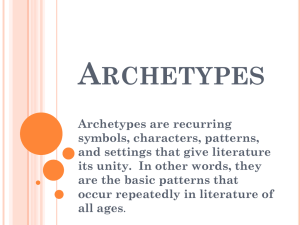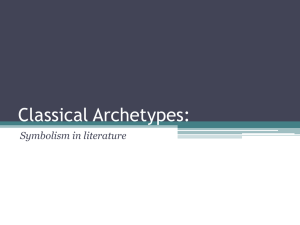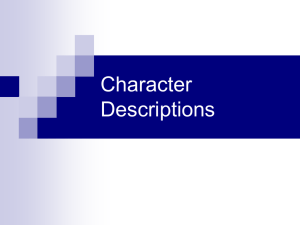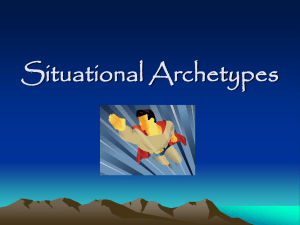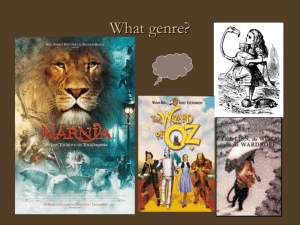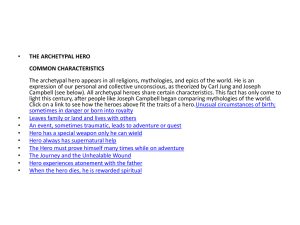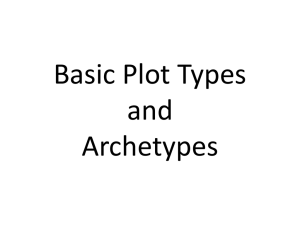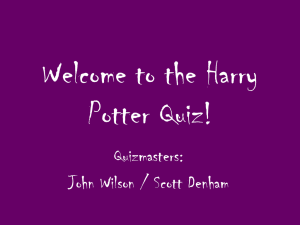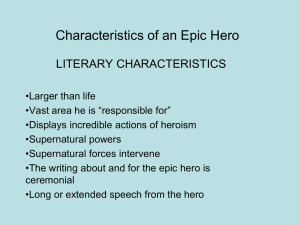Document 5487214
advertisement
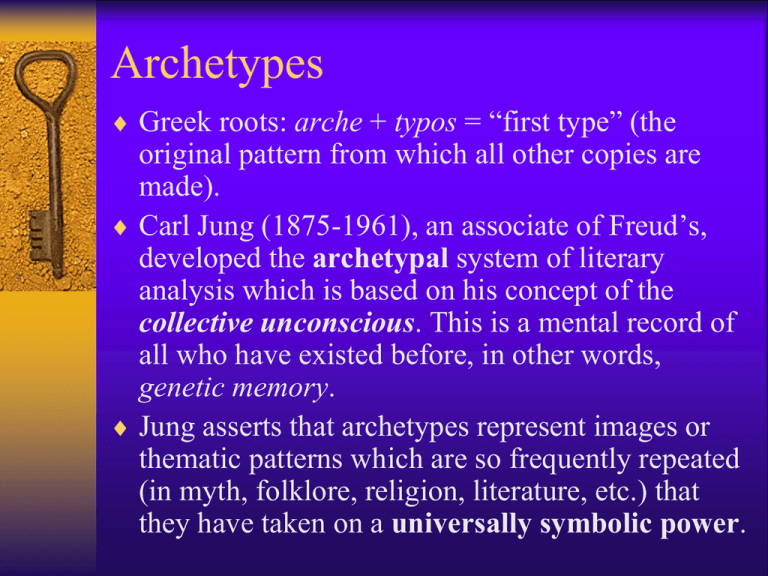
Archetypes Greek roots: arche + typos = “first type” (the original pattern from which all other copies are made). Carl Jung (1875-1961), an associate of Freud’s, developed the archetypal system of literary analysis which is based on his concept of the collective unconscious. This is a mental record of all who have existed before, in other words, genetic memory. Jung asserts that archetypes represent images or thematic patterns which are so frequently repeated (in myth, folklore, religion, literature, etc.) that they have taken on a universally symbolic power. Three Basic Qualities Jung asserts that there are three basic qualities which characterize archetypes: primordial, universal, and recurrent. Primordial Primordial is the most fundamental of qualities in which archetypes represent primeval concepts that have existed since the dawning of the species. In other words, instinctual! For example, migratory habits, food gathering, seeking shelter, ritual dances, fear of predators, etc. Universal Archetypes are unaffected by time, situation, community, or culture. They apply to every generation of every culture. Recurrent Archetypes repeat themselves generation after generation, despite time or place. Sort of like the beast that, when you chop off the head, another grows in its place. This comes from the basic human need for defining one’s place in the group or society. Three Types of Archetypes Archetypes are sorted into three categories: – Character – Situational – Symbolic Character Archetypes The Hero: Often, the hero’s life can be divided into 6 stages: – Stage 1: Virgin mother or unusual conception; attempt is made to kill him at birth. – Stage 2: Reared by foster parents, little is known of childhood. – Stage 3: Returns to the birth place; wins great battle or solves big problem. – Stage 4: Becomes king, marries princess. – Stage 5: Loses favor with gods, driven from the city. – Stage 6: Mysterious death (often on top of hill), no burial, but long after worshipped. (King Arthur, Oedipus, Jesus Christ) The Young Man from the Provinces Hero is raised by strangers (or extended family rather than parents) Returns to birthplace to solve big problem King Arthur, Luke Skywalker, Harry Potter The Initiate Young hero goes through training and ceremony before quest. Usually innocent and often wears white. King Arthur, Telemachus, Luke Skywalker, Harry Potter Mentor He/she is a teacher of the initiate Teaches skills by example Often takes on persona of role model or father/mother figure Merlin, Athena (as Mentor), Gandalf, Professor Dumbledore Father/Son Conflict Tension caused by separation during hero’s childhood or conflict when they meet again. Oedipus and Laios, Luke Skywalker and Darth Vader, Harry Potter and James (was James a bully???) Hunting Group of Companions Loyal companions who fight together The Knights of the Round Table, Robin Hood’s Merry Men, Ron and Hermione for Harry, Loyal Retainers Servants to the hero who willingly fight with or help the hero or another main character. The loyal retainer’s duty is to protect the hero and/or reflect the hero’s nobility. Sam Wise to Frodo, Watson to Sherlock Holmes, C3PO and R2D2 to Luke, Robin to Batman, Dobby and Kreacher, Harry’s House-Elves (though Dobby was technically free). Friendly Beast Animal companion of the hero. Symbolic of nature siding with the hero. Toto, Lassie, Hedwig, Trigger The Devil Figure Very evil character who offers worldly goods, fame, or knowledge for another’s soul. Satan, Voldemort, Wicked Witch of the West, the Emperor in Star Wars Evil Figure with Ultimately Good Heart Character who is evil or involved in wrongdoing, but later becomes good, saved by the love and/or nobility of the hero. Scrooge, Professor Snape, Green Knight, Darth Vader Scapegoat An animal or human whose death in a public ceremony gets rid of a sin or curse in the group. The death often makes the person more powerful in death than in life. Oedipus, Cedric Diggory, Dumbledore, Boromir (Lord of the Rings) Outcast Figure who is banished for a crime, real or imagined. Often becomes a wanderer. Cain, Sir Lancelot, Sirius Black and Lupin Creature of Nightmare A very scary monster who threatens the life of the hero. Often it is a perversion of the human body. Werewolves, vampires, huge snakes, Grendel, Fluffy, Basilisk, Dementors, Voldemort, Dracula, Frankenstein The Women Female Archetypes The Earthmother Offers spiritual or emotional nourishment to people who need it. Often depicted in earth colors with large breasts/hips symbolizing childbearing capabilities Virgin Mary, Mother Earth, Mrs. Weasely, Hera, Mammy in Gone with the Wind Temptress Sexy, sensual woman who attracts a man and causes his downfall; the femme fatale Delilah, Cleopatra, Morgana, Sirens, Aphrodite, Circe Damsel in Distress / The Virgin Vulnerable (virginal) woman who is saved by the hero Often used as bait by the villain Snow White, Sleeping Beauty, Princess Leia Platonic Ideal A source of inspiration and a spiritual ideal Respected for intelligence and spirituality rather than physical looks. Athena, the Virgin Mary, Hermione, Princess Leia Unfaithful Wife Sees husband as mundane Seeks passion from a younger, sexier man Guinevere, Mme. Bovary, Anna Karenina Star-Crossed Lovers Two characters madly in love, but are not meant to be together and, so, meet tragedy. Friends, family, or society disapprove of their romance. Tristan and Isolde, Romeo and Juliet, Lancelot and Guinevere, Mark Antony and Cleopatra, Elizabeth Taylor and Richard Burton (haha) Situational Archetypes The Quest – The search for someone or some special object which (if found and brought back) will restore the land and/or a ruler’s health. – The Holy Grail, Deliverance of the Ring: The Lord of the Rings, Rescue of the Princess, Search for Horcruxes The Task Deeds done to save the kingdom, win the fair lady, perform some nearly superhuman deed to win a position of power. Arthur pulls Excaliber, Psyche’s four tasks to win back Cupid, Harry Potter and the Seven Chambers – and the Basilisk – and killing Lord Voldemort The Journey (to the Underworld) (A) The hero goes into hell (real or psychological), forced to discover black truths (often about himself), must accept responsibility to leave hell. (B) Group of people goes on an isolated trip and is used as a microcosm of society The Odyssey, The Canterbury Tales (B), Disney’s Hercules, The Black Cauldron, Atlantis, Harry must face Voldemort in the forest and face his death. The Initiation Usually an introduction into adult life The adolescent comes into maturity with new awareness, problems, and hope for the community. Huckleberry Finn, Arthur, Harry Potter (hears and understands the prophecy), Luke Skywalker The Fall A descent from a higher to lower state of being because of a wrong action. Often the fall is accompanied by loss of innocence and/or being forced to leave a kind of paradise. Lucifer, Adam and Eve, Lancelot and Guinevere, King Lear, Harry being accused of lying about Voldemort’s return Death and Rebirth Real or symbolic Life cycle often parallels nature cycle. Morning and Springtime represent birth, youth, or rebirth; evening and winter represent old age and death; autumn is equated with aging and wisdom, summer is the prime of life, etc. Death of Bambi’s mother in Winter; the Phoenix; Shakespeare’s Sonnets Nature vs. the Mechanistic World Nature is often regarded as good, whereas science, technology, and society are evil. The Terminator, Jurassic Park, Planet of the Apes, The Time Machine, Rappacini’s Daughter, Austin Powers (yeah, Baby!) Battle between Good and Evil Battle between two primal forces Mankind shows eternal optimism in the portrayal of good triumphing over evil despite great odds. The Lord of the Rings, Star Wars, Harry vs. Voldemort The Unhealable Wound Either physical or psychological and cannot be healed fully Often indicates a loss of innocence Wounds ache and often drive the sufferer to desperate measures. Frodo’s Wound, Harry Potter’s scar, The Sun Also Rises The Ritual Ceremonies which mark the initiate’s passage into another stage of life Weddings, graduations, coronations, medal ceremony in Star Wars IV The Magic Weapon Symbolizes the extraordinary quality of the hero because no one else can use the weapon to its full potential. Usually given by a mentor figure. Excaliber; Thor’s hammer; Harry’s cloak and wand, and the Deathly Hallows Symbolic Archetypes Light vs. Darkness – Light represents hope, renewal, or intellectual illumination – Darkness represents the unknown, ignorance, or despair Water vs. Desert Water is necessary to live, and it is often a symbol of birth or rebirth Deserts are symbolic of death or hardship Nile River, Lady of the Lake, the rains at the end of Lion King, Luke’s home planet Heaven vs. Hell Man often associates hard to reach locations with dwelling places of supernatural forces. Skies/mountains are often the homes for forces of good. Bowels of the earth/underground, valleys, etc. are inhabited by diabolical forces. Mt. Olympus, swamp/underwater cave for Grendel Innate Wisdom vs. Educated Stupidity Some characters often show more wisdom and understanding than those in charge. Loyal retainers often exhibit this wisdom as they travel with the hero. R2D2 and C3PO; Harry and Hermione Haven vs. Wilderness Places of safety contrast sharply with the dangerous wilderness. Heroes often require respite in a haven to regain health and resources. Hospital wing/Weasleys’ Home; The Lord of the Rings – Rivendale (Elves’ Home); the Millennium Falcon Fire vs. Ice Fire represents knowledge, light, life/rebirth Ice is symbolic of ignorance, darkness, sterility, and death Stranger’s fire in the wilderness; Cold, dark castle of evil Supernatural Intervention The gods/supernatural forces step in on the side of the hero or sometimes against him. The Illiad, The Odyssey, Obiwan-Kenobi’s voice calling to Luke, Dumbledore’s presence at KingsCross Station and his parents and mentors appearance with the Deathly Hallows
